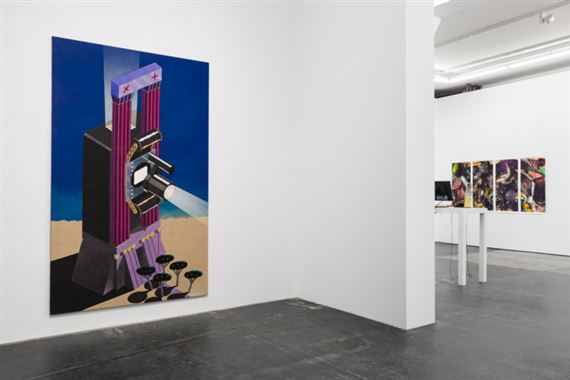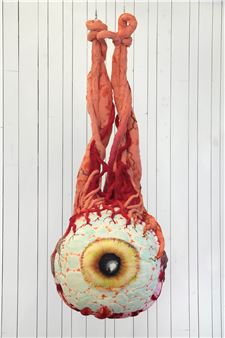Werethings
Galeria Plan B is pleased to announce the group exhibition Werethings curated by Mihnea Mircan with works of Raymond Barion, Becky Beasley, Camille Blatrix, Patricia L. Boyd, Sarah Browne, Erik Bû¥nger, Lauren Burrow, Alex Impey, Ana Maria Gomez Lopez, Victor Man, Nicholas Mangan, Jacqueline Mesmaeker, Simon Dybbroe Mû¡ller, Ana Prvacki, Mladen Stilinoviá, James Williamson and Ran Zhang to open on Friday, the 22nd of November 2019.
In his 1996 essay Vogelãs Net, the anthropologist Alfred Gell proposed that animal traps can be thought of as functional artworks and vice versa, that there is an operational similarity between traps apprehending their prey and the capture of attention in artworks. Both types of mechanisms intertwine environments, perspectives and intentions: traps and artworks rearrange, in the form of a weapon or in that of a question, perceptual or technological thresholds between worlds, or ways of being in worlds, boundaries that are turned into lures, snares or meandering interpretive pathways. While it does not focus on works explicitly preoccupied with the forms, signs or mechanics of trapping or on artistic projects that explore the posterity of the essay in conversations about the post-Duchampian canon and indigenous artefacts, this exhibition revisits Gellãs argument through a series of oblique takes on capture and entanglement, that reproduce the sway between potential energy and kinetic burst that unites the hunterãs design and the preyãs demise, between the concealment of the trap and the moment it reveals itself by springing shut. Werethings brings together works that inhabit spaces between species and modi operandi, ways of form- and sense-making, the visual and symbolic agency of ãpromiscuousã objects, Gellãs word for artefacts that move freely between transactional domains to activate an indefinite range of potentials. The exhibition thinks about things that draw and detain our thinking and make thinking accessible or imaginable as a kind of thing, things that do things and thus borrow the traits of personhood or usurp the prerogatives of the self, about relations between things that were and might return, futures and pasts, extinctions and emergences, about werethings that mutate, veer and swirl in much the same way that medieval werewolves and other metamorphic beasts transgressed the formal and moral frontiers of the monstrous.

Recommended for you
Galeria Plan B is pleased to announce the group exhibition Werethings curated by Mihnea Mircan with works of Raymond Barion, Becky Beasley, Camille Blatrix, Patricia L. Boyd, Sarah Browne, Erik Bû¥nger, Lauren Burrow, Alex Impey, Ana Maria Gomez Lopez, Victor Man, Nicholas Mangan, Jacqueline Mesmaeker, Simon Dybbroe Mû¡ller, Ana Prvacki, Mladen Stilinoviá, James Williamson and Ran Zhang to open on Friday, the 22nd of November 2019.
In his 1996 essay Vogelãs Net, the anthropologist Alfred Gell proposed that animal traps can be thought of as functional artworks and vice versa, that there is an operational similarity between traps apprehending their prey and the capture of attention in artworks. Both types of mechanisms intertwine environments, perspectives and intentions: traps and artworks rearrange, in the form of a weapon or in that of a question, perceptual or technological thresholds between worlds, or ways of being in worlds, boundaries that are turned into lures, snares or meandering interpretive pathways. While it does not focus on works explicitly preoccupied with the forms, signs or mechanics of trapping or on artistic projects that explore the posterity of the essay in conversations about the post-Duchampian canon and indigenous artefacts, this exhibition revisits Gellãs argument through a series of oblique takes on capture and entanglement, that reproduce the sway between potential energy and kinetic burst that unites the hunterãs design and the preyãs demise, between the concealment of the trap and the moment it reveals itself by springing shut. Werethings brings together works that inhabit spaces between species and modi operandi, ways of form- and sense-making, the visual and symbolic agency of ãpromiscuousã objects, Gellãs word for artefacts that move freely between transactional domains to activate an indefinite range of potentials. The exhibition thinks about things that draw and detain our thinking and make thinking accessible or imaginable as a kind of thing, things that do things and thus borrow the traits of personhood or usurp the prerogatives of the self, about relations between things that were and might return, futures and pasts, extinctions and emergences, about werethings that mutate, veer and swirl in much the same way that medieval werewolves and other metamorphic beasts transgressed the formal and moral frontiers of the monstrous.

 ARTISTS
ARTISTS













